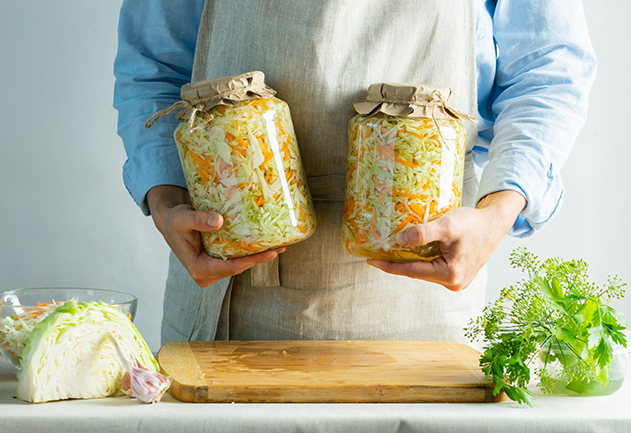Homemade sauerkraut is one of the simplest and most rewarding ferments you can make. With just cabbage, salt, and a bit of time, you’ll create a crisp, tangy, and probiotic-rich condiment that’s as delicious as it is nourishing. Fermentation enhances both the flavor and nutritional value, making sauerkraut a staple in traditional diets around the world. It’s endlessly versatile—serve it alongside sausages and roasted meats, tuck it into sandwiches, or enjoy it as a refreshing, zesty side dish. Adding spices or vegetables like carrots, garlic, or caraway seeds allows you to customize the flavor to suit your tastes.
INGREDIENTS:
1 medium-sized head of cabbage (green or red)
1 to 1.5 tablespoons of sea salt or kosher salt (avoid iodized salt or table salt)
Optional: Shredded carrots, caraway seeds, garlic, juniper berries, or other spices for flavoring
METHOD:
Prepare the Cabbage
- Wash the cabbage under cold water. Remove any damaged or wilted outer leaves.
- Quarter the cabbage and remove the tough core.
- Thinly slice the cabbage using a sharp knife, mandoline, or food processor.
Salt and Massage
- Place the shredded cabbage in a large mixing bowl. Sprinkle evenly with salt.
- Massage the cabbage with clean hands for 5–10 minutes, squeezing firmly until it softens and releases enough liquid to form a natural brine.
Add Flavorings (Optional)
- Mix in shredded carrots, garlic, caraway, or other spices if desired.
Pack the Jar
- Transfer the cabbage and its liquid into a clean glass jar or ceramic crock.
- Pack it down firmly to remove air pockets and ensure the cabbage is submerged in liquid. Add a little filtered water if needed.
- Place a fermentation weight (or a small jar filled with water) on top to keep the cabbage fully submerged.
Ferment
- Cover the jar loosely with a clean cloth or a lid set slightly ajar to allow gases to escape.
- Store in a cool, dark place (65–75°F / 18–24°C).
- Check every 1–2 days, pressing the cabbage down so it stays submerged. Skim off any foam if necessary.
Taste and Store
- After about 7 days, begin tasting. When it reaches the tanginess you like, transfer the sauerkraut to the refrigerator.
- For a stronger flavor, allow fermentation to continue for 2–3 weeks or longer.
- Refrigerated sauerkraut keeps for several months.




























